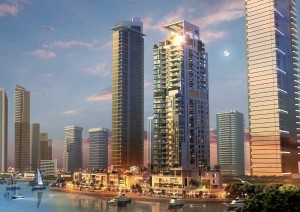A host of milestone events, development of iconic projects, diversification into new tourism segments are likely to bring growth to the Dubai tourism and hospitality sector next year, according to a report.
 Hotels in Dubai can look forward with optimism to increasing occupancies and average daily rate (ADR) through Q4 2009 and a positive outlook for 2010 and beyond, said the “Dubai Hospitality and Tourism Industry Outlook” report by PKF – The Consulting House, a specialist business advisory firm to the hotel and property sectors based in Dubai.
Hotels in Dubai can look forward with optimism to increasing occupancies and average daily rate (ADR) through Q4 2009 and a positive outlook for 2010 and beyond, said the “Dubai Hospitality and Tourism Industry Outlook” report by PKF – The Consulting House, a specialist business advisory firm to the hotel and property sectors based in Dubai.
The hospitality industry in Dubai has weathered the weak summer months better than expected, the report said.
Business travel is picking up again as Dubai is not only a hub destination but the main platform for conducting business in the region, it said.
Quoting the STR Global benchmark report, PKF said that occupancies at hotels in Dubai are significantly higher than the average for the region.
Dubai hotel occupancy for August stood at 64.1 per cent compared to the Mena average of 59.2 per cent. Hotel occupancy in Muscat stood at 38.2 per cent while hotels in Riyadh achieved 38.8 per cent occupancy, the report said.
However, the RevPAR (revenue per available room) for hotels in Dubai for August dropped 33.6 per cent over the same month last year (compared to a decline of 21 per cent for hotels across Mena).
Hotels in Dubai have been able to stabilise occupancy levels at 64 – 66 per cent over the summer at the expense of ADR which continued to decline 4 – 6 per cent month on month, it said.
However, PKF is of the opinion that ADRs are at or close to a bottom and that both ADR and occupancy should grow through December.
The report said it was too early to predict whether RevPAR will break $200 by the year’s end but this is likely during Q1 2010 boosted by Dubai Shopping Festival and events such as Gulfood Exhibition and the Dubai International Arabian Horse Championship.
Overall, the fact that RevPAR for Dubai’s hotels has declined only 35 per cent over record 2008 figures is remarkable considering that an additional 24 – 25 per cent of hotel and hotel apartment room supply was added over the same period (Q1 2009 vs. Q1 2008), the report said.
Looking forward to 2010 and beyond, the outlook for recovery and growth in arrivals and guest nights is positive. The twin engines of Dubai’s tourism industry — Dubai Department of Tourism and Commerce Marketing (DTCM) and Emirates Airlines – will help ensure growth in the short term (2010), it said.
DTCM continues to aggressively market Dubai in key generator markets while Emirates Airlines continues to grow its fleet and add destinations.
Dubai Airports itself has predicted that total passenger traffic is expected to grow by an additional 5.5 million (representing 13.5 per cent growth) to a staggering 46 million by 2010.
Growth in arrivals takes into consideration the additional arrivals expected due to the growth of the Dubai’s new budget carrier flydubai and the opening of Dubai World Central – Al Maktoum International Airport in H2 2010.
To put this into perspective, industry experts predict that in the long term, Dubai will become the fourth largest aviation hub (from its current rank of sixth) after Hong Kong, London Heathrow and Beijing, it said.
Arrivals do not necessarily translate to increased room nights but promotions such as that between Emirates and The Address which gave Emirates’ First and Business Class passengers one free night stay in Dubai are helping to convert passenger traffic into overnights.
In the near future, Destination Dubai will continue to enjoy the global spotlight which will undoubtedly boost tourism, as well as the successful launch of Dubai Metro, which created significant international publicity, it said.
Other milestone events over the next year that are expected to substantially boost the image of “Destination Dubai” include the launch of Burj Dubai, the opening of Al Maktoum International Airport in June 2010 and the opening of the Green Line of Dubai’s metro in late 2010.
Besides, Dubai is hosting a number of world class sports events, including the “Race to Dubai” golf competition at the Greg Norman designed Jumeirah Golf Estates, the Dubai World Cup horse race will be hosted next year at the impressive new Meydan race course and even international at the dedicated cricket stadium in Dubai Sports City.
There are of course the Rugby Sevens, the Dubai Tennis Championships and down the road, we have Tiger Wood’s Dubai (Al Ruwaya) to look forward to making Dubai a true golfing destination.Apart from sports tourism, the leisure tourism segment will be boosted by the opening of attractions at Dubailand in the mid-term.
Diversification into new tourism segments (sports, eco, medical, budget), increased promotion and opening of new generator markets (India, China, US, Africa), and enhanced and diversified transportation infrastructure and channels (new cruise terminal, budget carriers) all point towards a very healthy future for the tourism and hospitality
Industries, the report said.
For investors desiring to enter the hospitality industry, opportunities exist for distressed acquisitions in the immediate term, with owners of hotel properties developed at the market’s peak suddenly finding their properties not able to service debt, it said.
With many proposed hotel projects being cancelled, put on hold, or delayed, over-supply considerations have eased allowing investors with deep pockets and/or strong relationships with banks to consider new hotel development opportunities, it added.
















